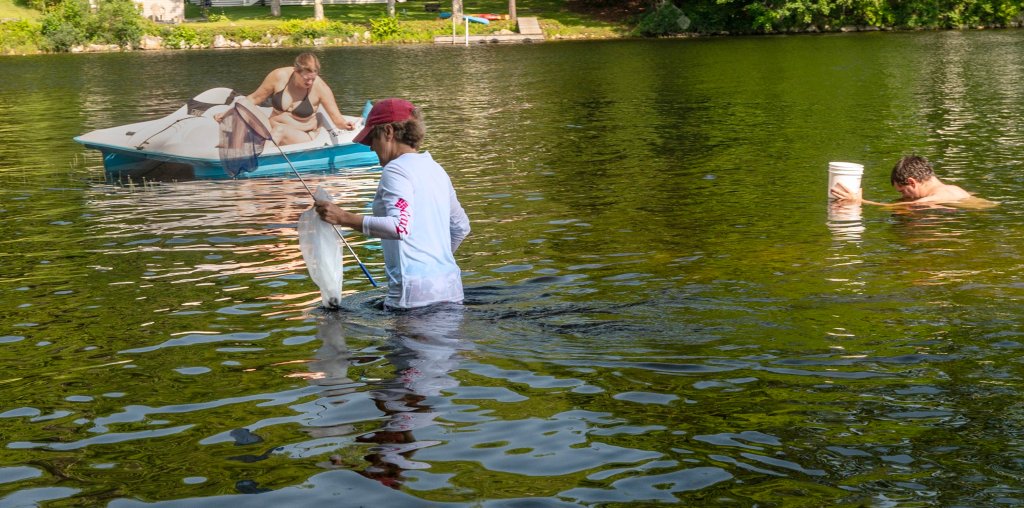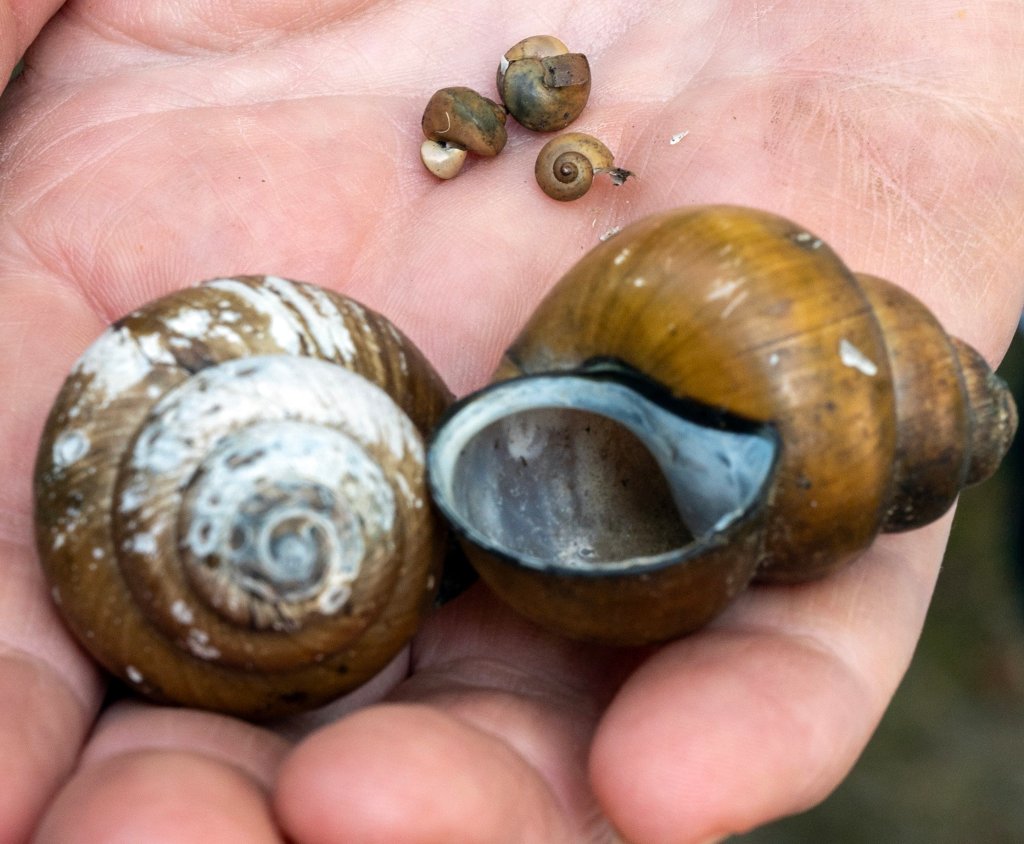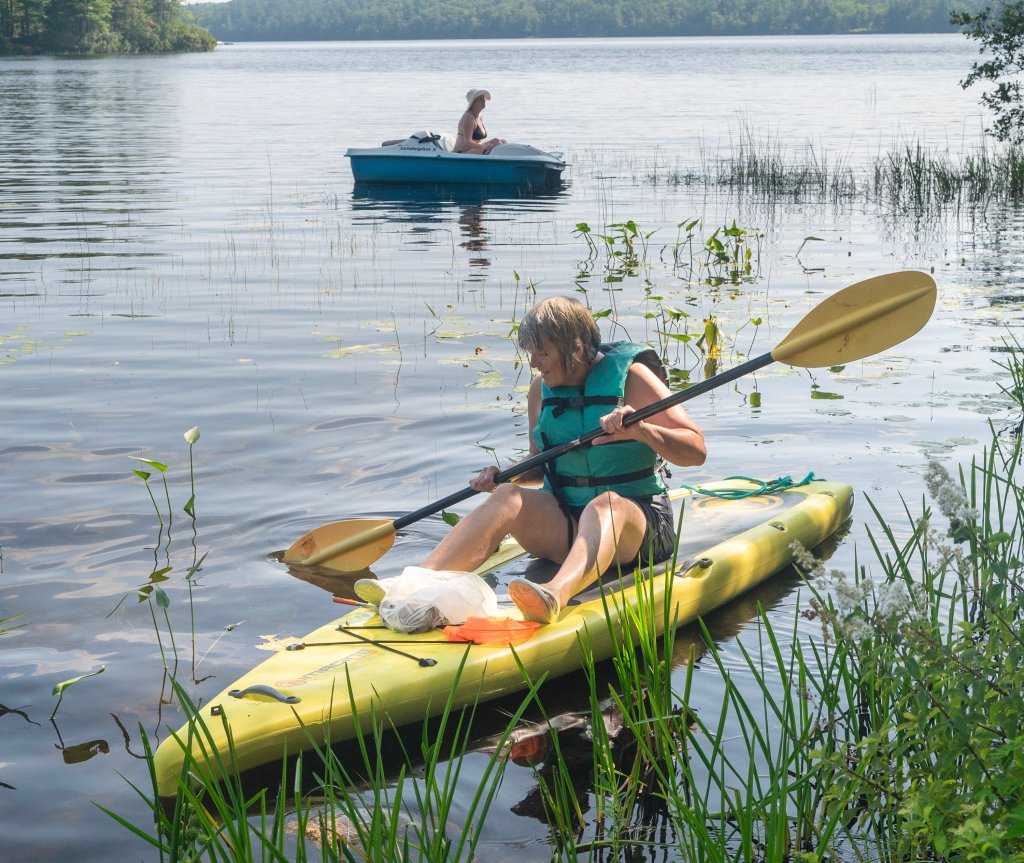WASHINGTON — At Washington Pond on Saturday morning, a small group of locals congregated with paddle boards, buckets and boats to collect and dispose of invasive snails threatening the ecological balance in the region.
The event, organized by the Washington Lakes Watershed Association, was aimed at catching the China Mystery Snails, which locals first discovered in the pond almost two years ago, and getting rid of them in an orderly fashion.

Two of the invasive snails caught by Kristina Dube are seen in a net Saturday during the Chinese Mystery Snail Derby on Washington Pond in Washington. Joe Phelan/Kennebec Journal
“We are concerned that they are going to change the balance of the lake,” said Kathleen Gross, a member of the association. “And so, we want to mitigate it as much as we can, if not totally.”
Gross said that people in the area are still unaware of these snails in the water, and even if they are, after catching them, most people don’t know what to do with them.
“Our solution was composting,” said Roxanne Eggan, another WLWA member, as she got herself ready to wade into the water on her paddle board.
She was joined by a couple of other members of the association and their families, some in a paddle boat, some equipped with a snorkel, dipping their heads underwater and emerging with big, brown, round snail shells.
To get rid of the snails, the members catch them and store them in freezers and then give them to a local composter in town. The snails are then layered with fresh horse manure and utilized as fertilizer.
HOW’D THEY GET TO MAINE?
The Chinese Mystery Snail is a peculiar name, and it stems from a peculiar history. No one knows exactly how a species native to Asia arrived here.

Eggan said that these snails could have come here as a food option for the Asian population who used to work on the rail tracks long ago. They are still sold online, and that is something the association hopes to discourage.
“It isn’t exactly known how this invasive species showed up, but it could have been the pet trade. People imported them here for aquariums or something else and that would have been the primary introduction,” said Derek Yorks, a wildlife biologist with the Maine Department of Inland Fisheries & Wildlife.
Yorks explained that after being imported, the snails could have been moved around by people or even birds, which would have been their secondary introduction.
According to the U.S. Geological Survey, Chinese Mystery Snails were first spotted in Maine in 1965. They have been found in multiple locations across Maine, other parts of New England, and even as far as the Midwest. USGS has recorded their presence in Clearwater Pond in Franklin, Annabessacook Lake in Winthrop, Sand Pond in Litchfield, and numerous other water bodies across the state.

Kristina Dube, left, Sarah Calland and Joe Moody hunt for invasive snails Saturday during a Chinese Mystery Snail Derby on Washington Pond in Washington. Moody collected the most snails during the derby, bagging 8.5 pounds of the molluscs. Joe Phelan/Kennebec Journal
The issues with the invasive snails are that they are big — they can grow as big as a golf ball — and they can reproduce asexually. When startled, experts say they release smaller snails out of their bodies, sometimes dozens at once.
Yorks added that these snails are successful invaders because they are what he calls generalists. They can survive in any habitat as they overwhelm the native species with their population, affecting feeding patterns and throwing the ecological balance into disarray.
Because of their size, these snails have die-offs, where a large group dies together in an area, leaving a pungent odor. Additionally, these snails can act as a host for parasites, including those harmful to humans.
EDUCATION IS KEY
This was the first time the association hosted an event, inviting people, especially children, to participate and catch snails. At the shore, three bags filled with prizes sat on a table to incentivize the participants.
Although the crowd was not as big as the hosts had expected, and had no children, they believed it was a good start for their mission to engage and inform on the issue. Last year the association formed a subcommittee to study the spread of invasive snails and how to curb it.
The association hopes educating locals will help stop the spread. Residents have been asked to drain and dry their boats after exiting the pond and to make sure they are not inadvertently carrying any snails on their boats that might end up infecting other waters. Additionally, remediation efforts are on, with similar events expected in the future.
After almost an hour, Gross rang a bell to signal the end of the hunt. The small group rowed back ashore, holding netted bags filled with snails. While others dried off, Gross weighed each bag to determine who won.
The winner, it turned out, was Eggan’s 45-year-old son, Joe Moody. He caught a bag of snails weighing 8 pounds, 8 ounces.
“I found a lot of them under the dock and intake pipes,” said Eggan, who caught 8 pounds, 7 ounces of snails. “We have to start telling the people living in camps along the pond.”
Send questions/comments to the editors.








